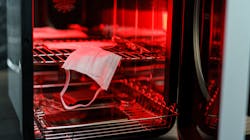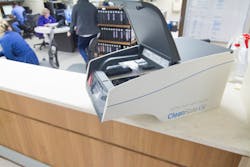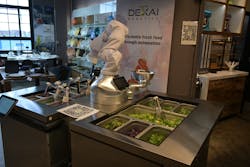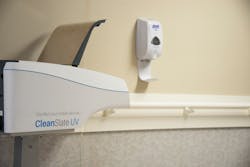Pandemic Protection Falls On Technology
The coronavirus pandemic raced around the globe during the past year, creating untolled upheaval and impacting lives in ways that have never been seen before.
While vaccines help solve the problem, a more salient question arises: How does a global community guard against future pandemics? There are certainly more answers than social distancing, masks, and business-killing shutdowns to keep people isolated and preventing them from going about routine activities.
Answers are emerging in the form of technology. Some of the products are small, some are large. Some are simple, others are technologically sophisticated. The primary purpose of the device might be related to disease control, but for others, it may be a side benefit.
The important part is that they all contribute to stopping the transmission of disease through human contact. Perhaps the world will never get to a place where diseases are no longer spread by human transmission, but advances in technology can certainly make it harder.
“We need new levels of global commitment and new models of collaboration among stakeholders to bring about innovative solutions and to translate these solutions into effective programs in settings where the needs are greatest,” the World Health Organization said. “The challenge is more than the pursuit of technological marvels and ‘magic bullets.’ It is about fostering a culture of innovation.”
Perhaps that culture is already here.
Soaring Numbers
According to a 2018 article in Scientific American, global outbreaks of infectious disease rose steadily from 1980 to 2010. “Viruses and bacteria were the most common causes of disease during those three decades,” the article said. “And the number of outbreaks driven by both person-to-person transmission and vectors such as insects climbed.”
Statistics for the Center for Disease Control also paint the picture. In 2017, approximately 15.5 million people in the U.S. visited physicians where the primary diagnosis was an infection or parasitic disease. Nearly 3.4 million people visited the emergency department, and 523,000 of that required admission to a hospital.
The reasons why communicable and infectious diseases are growing are varied. Weak immune systems, urbanization, deteriorating U.S. infrastructure, high unemployment levels, and even global warming are reasons behind the trend, according to Industrial Safety and Hygiene News. A growing movement against vaccinations has helped contribute to the increase.
Surprisingly, even hospitals are susceptible to infections. Roughly 1.7 million healthcare-acquired infections (HAIs) occur annually in hospitals, and nearly 100,000 people die. When nursing homes are included, the number of annual deaths linked to HAIs climbs to 400,000. Statistics from the coronavirus pandemic will certainly elevate those numbers.
Interesting Innovations
In 2020, CleanSlate UV in Toronto grew 1,200% year-over-year, according to the company’s statistics. The company’s almost overnight success proves there is a healthy market for technological innovations to help stop the spread of disease.
CleanSlate UV uses ultraviolet light to sanitize mobile devices including smartphones, tablets, and portable computers. The product can eradicate 99.998% of Methicillin-resistant Staphylococcus aureus (MRSA) in 20 seconds and does so without harsh, damaging chemicals. Some studies have discovered that approximately 94% of cell phones used by hospital staff bore contaminants.
“We wanted a product that had an intuitive design,” said Manjunath Anand, Chief Technology Officer for CleanSlate UV. “Infection prevention at any facility begins with staff and visitors. To enable the use of UV systems, simplicity and ease of use are important. An ideal UV system requires no training, allows easy integration into the workflow, and doesn’t require visitors to be trained.”
Intuitive use was also important in a hands-free door opener designed by MYT Wares of Brooklyn. The patent-pending, hands-free openers are affordable, easy-to-install devices that promote contactless, sanitary-safe entry. One of the design challenges for Etienne Sauret, Peter Coulombe, and the team at MYT Wares was to develop a product that people understood immediately what it was and how to use it without instruction.
“We went through a lot of different iterations of this product and it was either too hard to push down or it didn’t swivel nice enough or it swiveled too far,” Sauret said. “We had to figure out what the ideal angle of swivel would be for most people. There was a lot of trial and error.”
Robots and Face Shields
The sanitizer and the hands-free door opener give insight into the range of products that can be used to slow the spread of infectious disease. Two other applications, with an even greater extreme of technological sophistication, further illustrate the assortment of products that can slow down the spread.
At the height of the pandemic, a 3D printer manufacturer developed a face mask and placed the design on the internet for downloading, free of charge. igus, a Germany-based manufacturer of motion plastics, donated 100,000 headbands made with injection molding to apply to the face masks.
As schools opened last September, igus donated more than 220,000 face shields to schools in Rhode Island and Florida. The one-size-fits-all shields hold a replaceable sheet of plastic film that covers the entire face.
A more elaborate technological solution was designed by Dexai Robotics of Massachusetts. The company developed an automated solution for food preparation. The unit, called Alfred 2.0, allows for hands-free ordering that can be placed through any device with an internet connection. The robot also includes a subsystem for utensils.
“The COVID-19 pandemic has dramatically altered the way that we eat,” said Justin Rooney, a mechanical engineer on the Dexai team. “Hands-free orders reduce human proximity and contact with Alfred 2.0, thus reducing the chance of transferring pathogens. This feature should reduce the spread of infectious disease and keep food fresh for longer.”
Common Thread
The underlying theme in each of the applications is that each includes components from igus, which runs its North American operations out of Providence, R.I.
Each of the applications includes different igus products. The face shields, for instance, include the injection-molded straps. The CleanSlate UV devices feature drylin W guides. The hands-free door openers also include drylin shafts and iglide J sleeve bearing flanges. Alfred 2.0, the most complex of the devices, includes a slewing ring made with iglide properties and used an igus 3d printer filament to create custom, two-part bearings which are used as a cable management solution beneath the main robot garment.
“Traditionally, a solution like this would be prohibitively expensive,” said Cody Chu, Dexai’s design leader of the project. “This has been transformed thanks to igus’ robust selection of wear-resistant printer filaments. Limiting movement of cables on a 6 to 7 DOF robot arm to a predictable motion is a challenging problem in robotics.”
Some of the products, such as the CleanSlate UV sanitizer and the face shield, were designed specifically to help stop the spread of infectious diseases. The hands-free door opener, however, was designed primarily to help people open doors if they were carrying packages, briefcases or even coffee. “There are a lot of people who don’t like to touch door handles,” Sauret said. “The pandemic accelerated the process. We thought it was important to come up with something in response to that.”
The igus components offer unique advantages for each application, but for each of the designers the self-lubricating, long-lasting properties of the igus components were critical. The benefits of igus’ self-lubrication properties extend across many industries, but particularly so when the design objective is to reduce human interaction with equipment and stop the potential spread of communicable diseases. Having reliable, durable components—some igus components even have predictive maintenance capability—is a positive step for any machine designer.
“Failure or downtime of a UV system means no protection against infection transmission or quick adaptation to conventional cleaning methods,” Anand said. “Product reliability and longer mean time to failure are crucial over a long period of time. Depending on the design principles used, a lightweight system enables flexibility in deployments without disrupting the workflow.”
Anand said reducing the wear and tear increases the total lifetime value of the product and reduces the failure rates. “Material selection for the UV chamber poses a tough challenge to engineers as many plastics discolor or see degradation over a period of continuous UV exposure,’’ he said.
Tough Fight
Stopping the spread of communicable diseases will not be easy. As scientists learned with the coronavirus, there can be divergent strains. A report in 2018 from the World Health Organization said there were 30 new diseases that emerged in the previous 20 years.
Designing products that can fight off communicable diseases is challenging, too. “Determination of the optimal germicidal doses delivered by UV devices is complicated,” Anand said. “The germicidal effect of UV light on bacteria and viruses is primarily due to inactivation by DNA damage. Several factors can affect the UV light ability to induce DNA damage, mostly by shielding it, such as the thickness of the microorganism’s cell wall or membrane, the presence of organic or inorganic load, the level of microbial contamination, the physical nature of the object which may contain crevices, presence of biofilms, and the temperature. In addition, there is a possibility that the microorganism could activate self-repair mechanisms, which is initiated when insufficient UV light is exposed.”
Like COVID-19, many communicable diseases begin outside the United States and are tracked in by travelers. Finally, it can take years to have products tested and approved. Technology is evolving, but tests, trials, and production take time. The timeline for concept to completion can range between 12 months and 4 years in the UV field, Anand said.
Anand said advances in material science and manufacturing are required to support UV-C companies, especially, to bring effective and proven solutions to the market at a reasonable price. Product development is going to require time, money, and innovation. In the meantime, masks and all the other measures that are currently in place can help stop the spread. Innovative new products can help, too.
“Access to a wide variety of plastics that are resistant to UV-C light and lower wear and tear is always going improve the product reliability,’’ Anand said. “Technological advancements in manufacturing can speed up the product launch activities and bring the cost down. Eventually, organizations like igus can play an important role in keeping everyone safe.”






